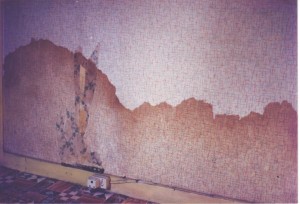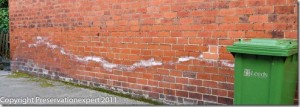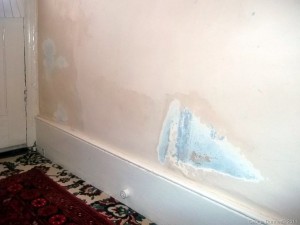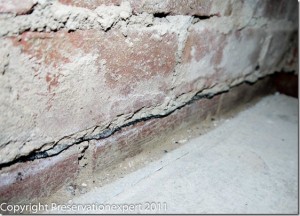Rising Damp for beginners (and homeowners).
So someone says your house has rising damp?
.
This isn’t a post about whether you have rising damp or not, that’s already been done before. What this post is about is a very basic explanation of what rising damp is and how it happens, what it can do and how it can be controlled, avoided or lived with.
Ever let a towel dangle over the edge of the bath and into the water? It can happen if you over-fill the bath and forget to remove it. If you have you will have seen how water is ‘wicked-up’ the material, sometimes several centimeters above the water line. It happens with a sponge dipped in water or if a piece of chalk is dipped in a puddle also.
This is a basic mechanism for rising damp and it affect all porous materials, other than those, which are water repellent.
Masonry is much heavier and denser than a towel so you’d think that it would be less prone to soaking up water. However, the opposite is the case, because water will rise higher in materials with smaller voids (called pores), than large ones, so in fact a brick wall may ‘wick-up’ water as rising damp a long way up – say a meter or so, whilst you would never get that effect with a towel.
All walls get wet at the base. This is due to rainfall and the subsequent surface water. Don’t be confused with talk of ‘water tables’ and such – these are not relevant to rising damp, which will happen in a house in valley and on top of a mountain. Water is always on or near the surface and the base of a wall is usually deeply embedded in the soil, often on a foundation. The ‘pore’ size of the masonry is usually smaller than that of the soil, so when it rains, whilst the soil may be well drained, the wall can wick-up quite a bit of water, which is retained for some time – this is all rising damp is.
We are not talking water in the sense of say a leaky gutter or condensation – the wall will rarely be wet to the touch (almost never). This is because the mechanical action of rising damp would need to be reversed for surface water to happen…. Why would a wall, constructed in fairly homogenous material, suck water in at the base and then push it out of the face higher up? Can’t happen.
The amount of water retained in the base of the wall can be enough to cause problems:
- Staining of decorations
- Rot in timber fixed or embedded in the wall near the base
- Damage to plaster, which becomes dry and friable or crumbly
- Damage to the external stones, pointing or bricks near the base, causing Flaking (spalling) and salting.
.
.
So to stop rising damp, all houses constructed these days and since about 1920 have physical damp proof courses. All these are, is a barrier in the bed-joint near the base of the wall, which do not have pores – they act to insulate the pores in the bricks or stones above them from contact with water in the ground.
These are made from impermeable materials like bitumen-impregnated textiles, poured bitumen or these days, usually plastic. Slate and courses of hard dense ‘blue’ bricks have been used also.
So rising damp is common and rare? How’s that?
Rising damp is very common because the rise of water through these materials is a physical fact. Given damp soil and a porous wall it will happen. However, some soils are so free draining that they do not retain rainwater for any length of time, so rising damp can be less common in some areas.
In saying that, rising damp, even if present may be slight and barely noticed (unless you use an electronic moisture meter to find it).
Another contradiction is that though it is common, it is also rare in houses, which already have a physical DPC, installed. So most of the time, when rising damp is present in a post war house, it is due to the DPC being bypassed (bridged), so that damp can rise past it, rather than through it. Nevertheless, survey reports do sometime refer to the existing damp course being ‘perished’ and damp proofing, in the form of a new DPC is recommended. In my experience most physical DPC’s are in good condition; despite the rising damp symptoms. Damp proofing may not be needed.
Where rising damp is present, but is not causing visible issues it may not be such a problem. However, there are cases where it will cause issues, such as damage to timber floor joists, skirting and such, An electronic moisture meter will detect very small amounts of moisture and there may even be a ‘rising damp profile’. Does this mean you should install a new DPC? Perhaps, but not certainly.
What a rising damp profile via a meter does confirm is that you need to consider treatment.
Treatment may be as innocuous as lowering a flowerbed that has been allowed to ‘bridge’ the original DPC. It may mean cutting back plaster in contact with a damp concrete floor.
It may also mean installing a new DPC, via chemical injection; the damp-proofing method. However, in cases where only an electronic moisture meter confirms there is a problem, we need to put that in perspective.
It’s rather like a doctor asking you in for a free health check. You feel fine but agree because you’re getting older and why not? He tells you that your blood pressure is a little high and perhaps you should get some exercise and lower your salt intake…. Fair enough. You rest easy and maybe take the advice, but don’t get too worried. That is like a surveyor visiting your house because it’s for sale and finding high moisture meter readings.
Then there are the other cases…. This time there are symptoms, which can’t be ignored. You feel tired all the time and when going up stairs you find yourself feeling dizzy. You call the doctor and after a consultation you are told you have high blood pressure and are prescribed some tablets… of course you take them; you’d be mad not to. This is the case where the high readings are accompanied by stains, salting or rot. In these case damp proofing and possibly timber treatment will be needed (though as mentioned the work could be basic maintanance rather than chemical treatment).
The reason that rising damp has become a contentious issue is that the ‘doctors’ (surveyors) are prescribing tablets and surger,y (chemical DPC’s) and such, when the symptoms are so slight, that only very sensitive equipment can find it. This is why damp proofing specialists like me are no longer trusted – there have been too many chemical DPC’s installed for insufficient reason.
I am not saying that rising damp; even technical rising damp found via a meter should be ignored, but I am saying it should be taken in the context of the situation. Expensive and disruptive intervention is not always required or justified.
Bryan Hindle CSRT CSSW AIOSH
For further reading on rising damp try these useful posts:
New technology in chemical Damp courses
How to choose a good damp specialist
Rising damp in Post war housing, an explanation of why it’s common




Great analogy and explanation of the process. Thank You
Glad you like it Akash,
Let me know if you need any points clarifying
Bryan
Hi- I have just bought an old edwardian era terrace house with damp problems in the rear extension. It is single brick wall with no cavity and a solid concrete floor. It had some fairly disgusting wooden cladding all the way round the kitchen. WHen I removed this I discovered damp and flaking brickwork between 1-1.5 metres on all 3 walls including an internal party wall. The house hasnt been lived in for at least several months. I am unsure if this is condensation or if there is some bridging going on around the concrete floor.
Any thoughts would be appreciated
Thanks
Andrew
Hi Andrew,
Single skin has no insulation value so condensation will always be a problem. However, it has been unoccupied so without people bathing washing and cooking, the humidity will be a lower (other than in a cold snap). Penetrating damp is also more likely with single skin. Rising damp too if the concrete floor is higher than the DPC – if there is one. Ground levels at, above or within 150mm of the internal floor will increase rainwater penetration along the base or even bridge the DPC.
Lots to think of here but sadly Andrew, I can’t really diagnose damp issues on the interweb. A dry lining system, independent of the walls or over a vertical membrane will present a dry service for decoration and could allow some insulation to be added too? But do check the external obvious issues first – pointing, ground levels, gutters and such.
Best wishes
Bryan
Hi Bryan,
Very good article with clear explanation especially to people like me who are familiar with medical jargon and everything related to housing is like greek and Latin.
I recently moved in to a house and in utility room an done wall in kitchen there was some wetness and peeling of paint near the skirting board.
One person came to have a look at it and suggested chemical injection. Is it a common intervention and effective one? i know prices will change but what is the average price for this in your view?
Thank you
Hi Bala,
Thanks for geting in touch – I’m glad you like the post I wrote – it was designed with you in mind. If the wall feels ‘wet’ when you touch it then I’m afraid that chemical injection is unlikely to work for that. Rising damp is the only thing which a chemical DPC will control effectively. Rising damp does not result in water on the surface of plaster or paint. That doesn’t necessarily mean there is no rising damp too, but the wet wall is likely to be caused by condensation. Has the utility an effective extractor fan installed? This is essential. If not, fix that first and then condensation should be reduced. Watch the situation and then have it re-inspected by a PCA member – contractor or independent surveyors can be found on the PCA web site (you’ll find my little firm there too if you are in Yorkshire).
Prices vary based on the thickness of the walls – the length and of course the amount of re-plastering needed, so it is very hard for me to give you guidance. However, the combined work involved in installing a DPC, along with hacking off plaster, removing and re-fixing skirting board and then mixing and applying new water resistant material, means that even small jobs take a couple of days, so don’t expect much change from £700 or so. DPC work can run into thousands on larger jobs so get more than one quite and make sure you do your homework to get a good installation. If a DPC is required make sure that you use a contractor who is a member of the PCA and ask them for a guarantee with guarantee Protection Insurance cover. This will avoid the problem of being left with a useless guarantee should another recession wipe-out the contractor, before the 20 year guarantee has expired.
Best regards
Bryan.
Hi Bryan
I am in the process of buying a property and have just discovered that it was treated (DPC) for rising damp and wood boring infestation in the roof area in 1998 (which I think had previously been treated) with a 30 year guarantee. Financially, this seems to me to be a nightmare. Are these problems likely to reoccur in the future? Can you advise on who I need to contact for expert advice. I am currently overwhelmed by it all.
Maggie
Hi Maggie,
Please don’t panic. It is very likely that the issue is old news if the roof has been treated before. As a buyer you should make sure that the house is surveyed by someone working for you – not the vendor.
You can get a survey free or quite cheaply from the Property Care Association find a member section of their web site http://www.property-care.org/PCSearch.asp
You can get an independent surveyor, consultant or a specialist contractor. I would go for a contractor firts as that will be cheaper and if there is anything wrong he can give you a quote for the repairs, so that you can negotiate with the vendor on the costs.
Once you have it you can double check the findings and remember that you are not under any obligation – you can always get second or third opinions – if possible you should try to meet the surveyor to ‘check him out’
If ther are any guarantees call the firm to make sure they are still trading and are not in dispute with the vendor or anything – get them to assign any guarantee to you.
best wishes
bryan
Dear Bryan,
I have an internal wall with rising damp. It’s a 1930s semi-detached house. There was no rising damp when I bourght it 20 years ago, the problem seemed to start after I had the central heating put in. I have been advised that the bitumen DPC may have corroded and the solution is to have a chemical DPC injected which does seem sensible to me, however, after reading your guidance I am starting to wonder if the DPC has indeed corroded and if so why would that happen only in this one part of the house? I have looked under the floor boards and can’t see anything that would obviously be acting as a bridge.
I am going to need to re-plaster the wall because it is badly damaged now, but I am unsure as to whether to also get the chemical DPC done.
I am in the Headingley area of Leeds.
Many thanks, Helen
Hi Helen,
If it is an internal wall with perished plaster along the bottom then it could be rising damp. I can’t diagnose this without seeing it. If the person who surveyed it showed good methodology and is a PCA member than it may be a correct diagnosis. If you are having to re plaster anyway, then the mess and disruption of that needs to considered, in deciding on a chemical DPC in one wall. The DPC should not be expensive, so it may be worth doing so that the new plasterwork, combined with the DPC will give you many years of trouble free dry plaster.
You are in Leeds so I can have a look, but I am very busy into February now.
best regards
bryan
Hi
We’ve just purchased a house with blatant (high readings and all of the obvious signs including palpable moisture ?) rising damp on internal and external walls and some floor areas buffing with the walls. Unfortunately we also have what appears to be penetrating damp from a disrepaired chimney which is possibly as far as internal first floor chimney breasts (dont judge it really is worth it ?). We have noticed in some areas behind the wallpaper the walls have been lined with polystyrene. We have read that this is a 1960s technique aimed at reducing condensation. The house is electric storage heater served (?). We are wondering that aswell as the many other possible causes and aggravating factors (build date c1915, close shrubbery and concrete, only one wall had cavities cleared out and only relatively recently…) that this interesting technique has actually worsened the damp issue within the property? Also any additional advice more than gratefully received. Thank you in advance ?
Hi Clair,
Electric storage heaters were expensive to run and if the house was kept on the cold side then condensation and mould may have led to the polystyrien…
Make sure there is good extraction in the kitchen and bathroom. Try to keep the house warm if you can. Maybe ask a qualifed suveyor to inspect?
Bryan